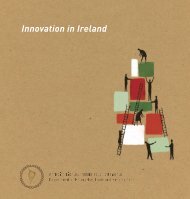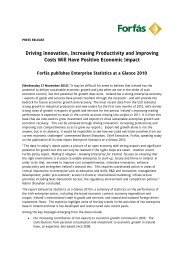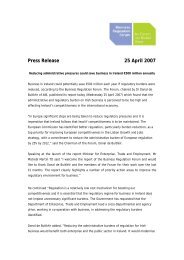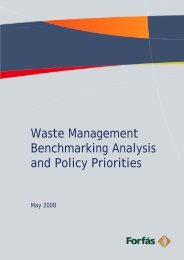Sustainability of Research Centres - Advisory Science Council
Sustainability of Research Centres - Advisory Science Council
Sustainability of Research Centres - Advisory Science Council
You also want an ePaper? Increase the reach of your titles
YUMPU automatically turns print PDFs into web optimized ePapers that Google loves.
An important feature <strong>of</strong> the scale is the shift in the underpinning rationale for research activity from<br />
public to private goods as the type <strong>of</strong> research undertaken changes from basic research to applied R&D.<br />
This shift is accompanied by a corresponding shift in sources <strong>of</strong> funding and location <strong>of</strong> research<br />
participants/activities from public to private i.e. the balance in funding shifts from 100% public funding on<br />
the left to 100% private funding on the right, and research participants shift from those located in public<br />
research organisations (including HEIs) 49 to those located in private sector R&D labs (whether as an in-<br />
house function or out-sourced as contract R&D). Between the two ends <strong>of</strong> the scale a range <strong>of</strong> models<br />
exist for supporting collaborative R&D activities with mixed funding, participation and location <strong>of</strong> research<br />
activities. Typical forms <strong>of</strong> research centres are shown along the top <strong>of</strong> Figure 3, illustrating their position<br />
on the scale - with academic research groups / departments and centres <strong>of</strong> excellence on the left, moving<br />
through collaborative academic-industry in the centre <strong>of</strong> the scale, to RTOs on the right 50 .<br />
This model for characterising research centres is sufficient for most types <strong>of</strong> research centres except<br />
government laboratories and centres with more mission-based or sector foci. For this reason, a separate<br />
category has been added to the right <strong>of</strong> the scale to enable these types <strong>of</strong> centres to be included. <strong>Centres</strong><br />
in this category typically conduct applied (and user inspired) research in support <strong>of</strong> public policy and R&D<br />
needs <strong>of</strong> the sector they are focused on. While some <strong>of</strong> the research they conduct may be nearer the basic<br />
end <strong>of</strong> the spectrum the research tends to be largely applied and highly focused on well defined<br />
application areas. Therefore, the centres fall on the right-hand side <strong>of</strong> the scale in terms <strong>of</strong> research<br />
conducted but on the left-hand side in terms <strong>of</strong> part <strong>of</strong> the rationale for the research. It is recognised that<br />
this is a generalisation, and that some centres may have a primary focus on societal outcomes with some<br />
secondary focus on commercial outcomes, whilst other centres may split more evenly their societal and<br />
commercial foci. A separate category has been added to the right <strong>of</strong> the scale (in purple) to enable these<br />
types <strong>of</strong> centres to be included.<br />
The scale illustrates that the relative proportion <strong>of</strong> industrial funding to a centre will increase from left to<br />
right- although it is not suggested that the funding increases linearly across the full scale, but rather there<br />
is a step change in the proportion <strong>of</strong> industry funding across the boundary <strong>of</strong> pre-competitive applied R&D<br />
and applied R&D. It should also be noted that the types <strong>of</strong> businesses that interact with centres and the<br />
forms <strong>of</strong> their interactions will also be different along the scale - and therefore the routes to<br />
commercialisation <strong>of</strong> research outputs, and ultimately wealth creation, will vary in both form and the<br />
timescales over which they occur for different types <strong>of</strong> centre. The typical types <strong>of</strong> industry interaction<br />
along the scale are illustrated in Figure 4. For example, on the far left, only science-based industries,<br />
pharmaceuticals in particular but also parts <strong>of</strong> ICT, materials and high-tech engineering, are able and<br />
willing to interact with universities. These will tend to be large multinational companies (MNCs) with<br />
considerable in-house R&D capabilities and budgets, in addition to a small number <strong>of</strong> high-tech small and<br />
medium enterprises (SMEs). Pharmaceutical companies, for example, fund pr<strong>of</strong>essorial chairs in<br />
universities and enter into long-term collaborative relationships with research groups and individual<br />
researchers. Similarly, ICT and high-tech engineering companies participate in collaborative basic research<br />
49 The term Public <strong>Research</strong> Organisation is usually taken, in Europe at least, to include universities and public research laboratories and institutes.<br />
50 The various categories <strong>of</strong> research centres used in Figure 3 are described in Appendix 3.<br />
<strong>Sustainability</strong> <strong>of</strong> <strong>Research</strong> <strong>Centres</strong> 16 June 2012

















